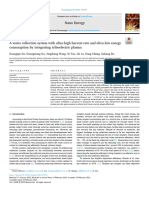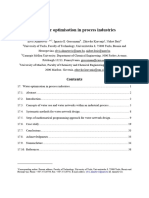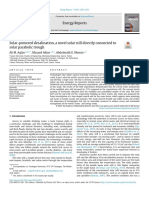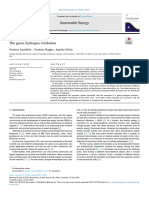0 ratings0% found this document useful (0 votes)
2 viewsAssignment 6
Assignment 6
Uploaded by
Gia ĐạiCopyright:
© All Rights Reserved
Available Formats
Download as DOCX, PDF, TXT or read online from Scribd
Assignment 6
Assignment 6
Uploaded by
Gia Đại0 ratings0% found this document useful (0 votes)
2 views6 pagesCopyright
© © All Rights Reserved
Available Formats
DOCX, PDF, TXT or read online from Scribd
Share this document
Did you find this document useful?
Is this content inappropriate?
Copyright:
© All Rights Reserved
Available Formats
Download as DOCX, PDF, TXT or read online from Scribd
Download as docx, pdf, or txt
0 ratings0% found this document useful (0 votes)
2 views6 pagesAssignment 6
Assignment 6
Uploaded by
Gia ĐạiCopyright:
© All Rights Reserved
Available Formats
Download as DOCX, PDF, TXT or read online from Scribd
Download as docx, pdf, or txt
You are on page 1of 6
Outline
Chapter 1: General Introduction
1.1 Motivation for Solar-Powered Water Desalination research
- Water scarcity is still a pressing issue in many regions. The application of
membrane technology through water desalination to convert brackish to
potable water is a promising technology to solve this issue. (Elma,
Mujiyanti et al. 2020)
- The energy shortage and clean water scarcity are two key challenges for
global sustainable development. Near half of the total global water
withdrawals is consumed by power generation plants while water
desalination consumes lots of electricity.(Wang, Shi et al. 2019)
- The purification of waste water and the desalination of seawater are now
current essential technologies. Especially the production of fresh water from
seawater is an effective solution to recent severe water shortage problem.
(Fujiwara and Kikuchi 2017)
1.2 Objectives
- In this research, the porous structures will be precisely designed and
fabricated by using photo-curing 3D printer, allowing us to investigate the
structure effects on energy transferring efficiency. The graphene additive
are also applied in the porous layer for further enhancement of heat
generation. The evaporation tests will be then performed under 1 sun
irradiation. The graphene-resin layers will be supposed to absorb solar
irradiation as well as transfer it to heat energy productively.
Chapter 2: Literature review
2.1 Shortage of water – Overview
- Water scarcity is a global issue that is threatening social and economic
development. One approach to alleviating scarcity is the incorporation of
new water sources into supply systems, including desalinated seawater for
industrial and municipal use. (Alvez, Aitken et al. 2020)
- Water scarcity is an expanding climate and human related condition, which
drives and interacts with other stressors in freshwater ecosystems such as
chemical pollution. (Arenas-Sanchez, Rico et al. 2016)
- Water resources are increasingly being overexploited, such that current food
production, which relies heavily on irrigation schemes, is unsustainable.
Many steps, including improved irrigation techniques, more water-efficient
crops and animal protein production, etc., will be needed to raise water
productivity across the board. Water must in future be recognised as a
scarce resource and not taken for granted. (Brown 2001)
2.2 Seawater Desalination and Methods of Desalination
- With the worsening water scarcity problem, seawater desalination has been
receiving gradually increasing attention. Ion adsorptive desalination was
introduced as one of the seawater desalination techniques. (Lee, Lim et al.
2020)
- The mechanism of the salt rejection in a surface-charged nanopore is
mainly attributed to the ion concentration difference between the cations
and anions induced by the surface charges. Increasing surface charge
density is beneficial to enhance ionic selectivity.(Li, Qiu et al. 2018)
- Currently, various disposal methods have been practiced, including surface
water discharge, sewer discharge, deep-well injection, evaporation ponds
and land application. However, these brine disposal methods are
unsustainable and restricted by high capital costs and non-universal
application. Nowadays, brine treatment is considered one of the most
promising alternatives to brine disposal, since treatment results in the
reduction of environmental pollution, minimization of waste volume and
production of freshwater with high recovery. (Panagopoulos, Haralambous
et al. 2019)
- Biofouling in seawater reverse osmosis (SWRO) membranes is a critical
issue faced by the desalination industry worldwide. The major cause of
biofouling is the irreversible attachment of recalcitrant biofilms formed by
bacteria and their extracellular polymeric substances (EPS) on membrane
surfaces. (Nagaraj, Skillman et al. 2018)
2.3 Solar Evaporation and Control of structure
- The main challenges of a solar steam generation device based on biomass
materials are complicated processing techniques and relatively low
efficiency. (Yang, Chen et al. 2020)
- In recent years, interfacial solar vapor generation has shown great potential
in realizing desalination and wastewater treatment with high energy
conversion efficiency. However, high evaporation rate cannot be
maintained because of the seemingly unavoidable fouling or salt
accumulation on the solar absorbers. (Xu, Li et al. 2019)
- The realization of solar-driven water evaporation by using effective
converters has attracted considerable attention in recent years owing to its
potential for seawater desalination and wastewater treatment. (Wang, Wu
et al. 2020)
- Solar-driven interfacial evaporation aiming at producing clean water
without conventional energy consumption. Nevertheless, complex
preparation processes and costly absorber materials might be the
challenges for the practical application of this technology. (Yin, Hsin et al.
2020)
2.4 3D Printer – DLP
- Multi-material 3D printing with several mechanically distinct materials at
once has expanded the potential applications for additive manufacturing
technology. Fewer material options exist, however, for additive systems
that employ vat photopolymerization (such as stereolithography, SLA, and
digital light projection, DLP, 3D printers), which are more commonly used
for advanced engineering prototypes and manufacturing. Those material
selections that do exist are limited in their capacity for fusion due to
disparate chemical and physical properties, limiting the potential
mechanical range for multi-material printed composites. (Borrello, Nasser
et al. 2018)
- One of the major challenges in 3D printing of microfluidic devices using a
digital light processing (DLP) desktop printer is that the static liquid resin
trapped in the channels, once the "ceiling" is printed, still receives small
doses of light through the subsequently printed layers. This easily triggers
partial polymerisation of the resin which impedes its flushing out of the
channels after completion of the printing session. (van der Linden, Popov
et al. 2020)
2.5 Graphene & Synthesis methods of Graphene
- Surface modification of graphene oxide (GO) is one of the most important
issues to produce high performance GO/epoxy composites. In this
research, the dimethylformamide (DMF) was introduced onto the surface
of GO sheets by a cheap and simple method, to prepare a reinforcing filler,
as well as a catalyst in epoxy resin. (Lyu, Yan et al. 2017)
2.6 Solar Evaporation related to Graphene
- Solar interfacial evaporation has been recognized as a versatile energy
conversion protocol for cutting-edge applications such as water treatment
and power generation (e.g., hydro voltaic effect). Recently, to enhance
water evaporation rates, water temperature and evaporation area have been
considered as essential ingredients, and thus photothermal materials and
three-dimensional hierarchical structures have been developed to promote
light-to-heat conversion efficiency and enhance interfacial evaporation.
However, less attention has been paid to the airflow effect, because the
interfacial floatability of photothermal membranes should be considered
under air blast. (Han, Chen et al. 2020)
- Recently, interfacial solar steam generation has drawn much attention. The
technique holds a promise for developing a sustainable off-grid and
decentralized water supply system and providing low-energy solutions for
brine management. High-performance solar steam generation system
requires four components: absorbers with excellent photothermal
conversion efficiency, thermal insulators reducing the heat loss, channels
for water transport, and the well-designed steam collection device.
Plasmonic metal nanomaterials and carbon-based materials such as
graphene, graphene oxide and carbon nanotubes are the two main groups
of absorbers for harvesting solar energy. (Huang, Ling et al. 2020)
Chapter 3: Experimental Materials and Methods
3.1 Preparation Resin/Graphene
- Graphene was chemically functionalized by hydrothermal reduction of
graphene oxide (GO) suspension in N-methyl-2-pyrrolidone (NMP). Then,
NMP-graphene was dispersed in N-dimethylformamide (DMF) and added
to resin (B24C30) with magnetic stirring. The 3D printer we used was DLP
(digital light processing), where the curing wavelength and time was
405nm and 12 sec per layer.
3.2 Layers Model Design
- In the first part, several porous structures, including straight channel, cone-
shaped channels with various sliding angles, zigzag-shaped channel and
interconnected pores, were fabricated for the energy transferring layer. The
pore size, porosity and wire diameter were controlled, followed by the
adjustment of graphene amounts.
3.3 Fabrication Assessment
- According to the design sketch and images of printed products, the errors
of porous structures must be less than 5%. The results should prove that the
structures create in this research was highly accurate, which is achieved by
DLP 3D printer. More important, the resin with graphene additive could be
highly printable. The density of porous layer is supposed to be much lower
than 1 g/cm3 and the glass transition temperature are very high, that can
lead to the stability of this solar-energy absorbing layer for long-term
operation
Chapter 4: Results & Discussion
4.1 Temperature Difference – Thermal Images
4.2 Floating Days test
4.3 Mass Changes over Time
4.4 Evaporation Rate
Chapter 5: Conclusion & Future Perspective
References
Alvez, A., D. Aitken, D. Rivera, M. Vergara, N. McIntyre and F. Concha (2020). "At
the crossroads: can desalination be a suitable public policy solution to address water
scarcity in Chile's mining zones?" J Environ Manage 258: 110039.
Arenas-Sanchez, A., A. Rico and M. Vighi (2016). "Effects of water scarcity and
chemical pollution in aquatic ecosystems: State of the art." Sci Total Environ 572:
390-403.
Borrello, J., P. Nasser, J. Iatridis and K. D. Costa (2018). "3D Printing a
Mechanically-Tunable Acrylate Resin on a Commercial DLP-SLA Printer." Addit
Manuf 23: 374-380.
Brown, L. R. (2001). "How water scarcity will shape the new century." Water Sci
Technol 43(4): 17-22.
Elma, M., D. R. Mujiyanti, N. M. Ismail, M. R. Bilad, A. Rahma, S. K. Rahman,
Fitriani, A. Rakhman and E. L. A. Rampun (2020). "Development of Hybrid and
Templated Silica-P123 Membranes for Brackish Water Desalination." Polymers
(Basel) 12(11).
Fujiwara, M. and M. Kikuchi (2017). "Solar desalination of seawater using double-
dye-modified PTFE membrane." Water Res 127: 96-103.
Han, D. D., Z. D. Chen, J. C. Li, J. W. Mao, Z. Z. Jiao, W. Wang, W. Zhang, Y. L.
Zhang and H. B. Sun (2020). "Airflow Enhanced Solar Evaporation Based on Janus
Graphene Membranes with Stable Interfacial Floatability." ACS Appl Mater
Interfaces 12(22): 25435-25443.
Huang, L., L. Ling, J. Su, Y. Song, Z. Wang, B. Z. Tang, P. Westerhoff and R. Ye
(2020). "Laser-Engineered Graphene on Wood Enables Efficient Antibacterial, Anti-
Salt-Fouling, and Lipophilic-Matter-Rejection Solar Evaporation." ACS Appl Mater
Interfaces 12(46): 51864-51872.
Lee, S. J., H. W. Lim and S. H. Park (2020). "Adsorptive seawater desalination using
MOF-incorporated Cu-alginate/PVA beads: Ion removal efficiency and durability."
Chemosphere: 128797.
Li, Z., Y. Qiu, K. Li, J. Sha, T. Li and Y. Chen (2018). "Optimal design of graphene
nanopores for seawater desalination." J Chem Phys 148(1): 014703.
Lyu, Q., H. Yan, L. Li, Z. Chen, H. Yao and Y. Nie (2017). "Imidazolium Ionic
Liquid Modified Graphene Oxide: As a Reinforcing Filler and Catalyst in Epoxy
Resin." Polymers (Basel) 9(9).
Nagaraj, V., L. Skillman, D. Li and G. Ho (2018). "Review - Bacteria and their
extracellular polymeric substances causing biofouling on seawater reverse osmosis
desalination membranes." J Environ Manage 223: 586-599.
Panagopoulos, A., K. J. Haralambous and M. Loizidou (2019). "Desalination brine
disposal methods and treatment technologies - A review." Sci Total Environ 693:
133545.
van der Linden, P., A. M. Popov and D. Pontoni (2020). "Accurate and rapid 3D
printing of microfluidic devices using wavelength selection on a DLP printer." Lab
Chip 20(22): 4128-4140.
Wang, C. F., C. L. Wu, S. W. Kuo, W. S. Hung, K. J. Lee, H. C. Tsai, C. J. Chang and
J. Y. Lai (2020). "Preparation of efficient photothermal materials from waste coffee
grounds for solar evaporation and water purification." Sci Rep 10(1): 12769.
Wang, W., Y. Shi, C. Zhang, S. Hong, L. Shi, J. Chang, R. Li, Y. Jin, C. Ong, S. Zhuo
and P. Wang (2019). "Simultaneous production of fresh water and electricity via
multistage solar photovoltaic membrane distillation." Nat Commun 10(1): 3012.
Xu, N., J. Li, Y. Wang, C. Fang, X. Li, Y. Wang, L. Zhou, B. Zhu, Z. Wu, S. Zhu and
J. Zhu (2019). "A water lily-inspired hierarchical design for stable and efficient solar
evaporation of high-salinity brine." Sci Adv 5(7): eaaw7013.
Yang, J., Y. Chen, X. Jia, Y. Li, S. Wang and H. Song (2020). "Wood-Based Solar
Interface Evaporation Device with Self-Desalting and High Antibacterial Activity for
Efficient Solar Steam Generation." ACS Appl Mater Interfaces 12(41): 47029-47037.
Yin, M., Y. Hsin, X. Guo, R. Zhang, X. Huang and X. Zhang (2020). "Facile and low-
cost ceramic fiber-based carbon-carbon composite for solar evaporation." Sci Total
Environ: 143546.
You might also like
- Green Hydrogen Supply: A Guide to Policy MakingFrom EverandGreen Hydrogen Supply: A Guide to Policy MakingRating: 5 out of 5 stars5/5 (1)
- Horizontal Stiffener: Mahesh .B .JDocument24 pagesHorizontal Stiffener: Mahesh .B .JHarsh BhimaniNo ratings yet
- AASHTO Test ProceduresDocument126 pagesAASHTO Test ProceduresJi Ding100% (5)
- Photothermal Membrane Distillation Toward Solar Water ProductionDocument17 pagesPhotothermal Membrane Distillation Toward Solar Water Productionraniahamizi006No ratings yet
- s11356-022-19625-wDocument20 pagess11356-022-19625-wBùi Thành PhướcNo ratings yet
- s11356-022-19625-wDocument20 pagess11356-022-19625-wBùi Thành PhướcNo ratings yet
- Opportunities and Challenges of Seawater DesalinatDocument4 pagesOpportunities and Challenges of Seawater DesalinatPablo ViveroNo ratings yet
- 53 IJGE Sankeerthana 2021Document23 pages53 IJGE Sankeerthana 2021oudssfsdNo ratings yet
- 1 s2.0 S1383586621013290 MainDocument11 pages1 s2.0 S1383586621013290 Main김종구No ratings yet
- 13 1-S2.0-S0011916417321604-Main PDFDocument40 pages13 1-S2.0-S0011916417321604-Main PDFDaniel Camilo CanoNo ratings yet
- Abdallah 2020Document10 pagesAbdallah 2020Piotr KucharskiNo ratings yet
- 10.5541-ijot.1012365-2036927Document21 pages10.5541-ijot.1012365-2036927niraj kumarNo ratings yet
- Enhancing the Performance of Solar Stills Using He 2024 International JournaDocument14 pagesEnhancing the Performance of Solar Stills Using He 2024 International JournayunlongNo ratings yet
- A Review of Membrane Processes and Renewable Energies For DesalinationDocument18 pagesA Review of Membrane Processes and Renewable Energies For DesalinationThipsuree KornboonraksaNo ratings yet
- A Review On Evaporation Improvement of Solar Still Desalination Using Porous MaterialDocument15 pagesA Review On Evaporation Improvement of Solar Still Desalination Using Porous MaterialmoumineensaNo ratings yet
- 52-Alum Sludge ReviewDocument46 pages52-Alum Sludge ReviewBinyam KebedeNo ratings yet
- Economic and LCA of Recycling EoL Silicon PV Modules (Lim - 2022)Document13 pagesEconomic and LCA of Recycling EoL Silicon PV Modules (Lim - 2022)Ioannis BoukisNo ratings yet
- Journal of Building Engineering: Habib Ajdari, Abolhasan AmeriDocument10 pagesJournal of Building Engineering: Habib Ajdari, Abolhasan AmeriAbolhasan AmeriNo ratings yet
- Materials Today: Proceedings: Deepak N. Paithankar, Satish G. TajiDocument8 pagesMaterials Today: Proceedings: Deepak N. Paithankar, Satish G. TajiOscarNo ratings yet
- Utilization of Solar Energy For Wastewater Treatment: Challenges and Progressive Research TrendsDocument23 pagesUtilization of Solar Energy For Wastewater Treatment: Challenges and Progressive Research Trendsmarceltubia0No ratings yet
- Applications of Capacitive DeionizationDocument13 pagesApplications of Capacitive DeionizationDuong DatNo ratings yet
- 2D Photothermal MaterialsDocument24 pages2D Photothermal MaterialsHoàng TrầnNo ratings yet
- 34 2022 J Petroleum ME - Volume 23 - Issue 2 - Pages 57-69Document13 pages34 2022 J Petroleum ME - Volume 23 - Issue 2 - Pages 57-69Abo AmroNo ratings yet
- Shukla 2022 J. Phys. Conf. Ser. 2178 012018Document11 pagesShukla 2022 J. Phys. Conf. Ser. 2178 012018Nayak KaushikaNo ratings yet
- 5 9 PDFDocument9 pages5 9 PDFsandeepNo ratings yet
- A Water Collection System With Ultra-High Harvest Rate and Ultra-Low Energy Consumption by Integrating Triboelectric PlasmaDocument9 pagesA Water Collection System With Ultra-High Harvest Rate and Ultra-Low Energy Consumption by Integrating Triboelectric Plasmaemiliomarino356No ratings yet
- 1-s2.0-S001393512300110X-mainDocument11 pages1-s2.0-S001393512300110X-mainvinicius.aug.silvaNo ratings yet
- EcoMat - 2022 - Hu - The Promising Solar Powered Water Purification Based On Graphene Functional ArchitecturesDocument15 pagesEcoMat - 2022 - Hu - The Promising Solar Powered Water Purification Based On Graphene Functional ArchitecturesKlent Stalin HermiasNo ratings yet
- Membranes and The Water Cycle - Challenges and OpportunitiesDocument7 pagesMembranes and The Water Cycle - Challenges and Opportunitiestu vuuNo ratings yet
- 2020 MWT11 A Column Study For Effect of Filter Media On The Performance of Sand FilterDocument10 pages2020 MWT11 A Column Study For Effect of Filter Media On The Performance of Sand FilterMi doremiNo ratings yet
- Ws 022128500Document27 pagesWs 022128500linhNo ratings yet
- Energy-Water Nexus in Seawater Desalination Project A Typical Water Liu2020Document11 pagesEnergy-Water Nexus in Seawater Desalination Project A Typical Water Liu2020bazediNo ratings yet
- My Proposal 1Document16 pagesMy Proposal 1Rahi FurqanNo ratings yet
- Water Harvesting From Fog Using Building Envelopes Part IIDocument10 pagesWater Harvesting From Fog Using Building Envelopes Part IIjeremy.costaNo ratings yet
- Book Chapter Water Optimisation in Process Industries FinalDocument44 pagesBook Chapter Water Optimisation in Process Industries FinalHari RayNo ratings yet
- Thermal DelaminationDocument8 pagesThermal DelaminationTom HNo ratings yet
- 1 s2.0 S277294002300005X MainDocument6 pages1 s2.0 S277294002300005X MainAswin SanthoshNo ratings yet
- Reference 1Document9 pagesReference 1mahbub1332No ratings yet
- Self Cleaning and Self Cooling PhotovoltDocument8 pagesSelf Cleaning and Self Cooling Photovoltkvnabnte24No ratings yet
- Opportunities For Reducing The Supply Chain Water Footprint of Metals Used in Consumer ElectronicsDocument15 pagesOpportunities For Reducing The Supply Chain Water Footprint of Metals Used in Consumer Electronicssamia.janan20No ratings yet
- Applications of TiO2 Jackfruit Peel Nanocomposites in - 2022 - Case Studies inDocument18 pagesApplications of TiO2 Jackfruit Peel Nanocomposites in - 2022 - Case Studies inCad TutorNo ratings yet
- Techno EDDocument9 pagesTechno EDSafa alkhalilNo ratings yet
- Solar Powered Desalination A Novel Solar Still Directly Connected To Solar Parabolic TroughDocument10 pagesSolar Powered Desalination A Novel Solar Still Directly Connected To Solar Parabolic TroughPUBG SORRYNo ratings yet
- Mohammed Hamdan, Maysa SarsourDocument8 pagesMohammed Hamdan, Maysa SarsourShahzeb FarooqNo ratings yet
- Di Capua Et Al 2022Document14 pagesDi Capua Et Al 2022Lundi HaroNo ratings yet
- Paper On SoilingDocument7 pagesPaper On SoilingSuchanond KaewjindaNo ratings yet
- 1-s2.0-S0038092X2300186X-mainDocument27 pages1-s2.0-S0038092X2300186X-mainvinicius.aug.silvaNo ratings yet
- Improvement of Water Harvesting Performance Through Collector Modification in Industrial Cooling TowerDocument9 pagesImprovement of Water Harvesting Performance Through Collector Modification in Industrial Cooling TowerKumar VishwajeetNo ratings yet
- Solar-Driven Hydrogel-Based Interfacial Evaporators - From Principles To Material ManipulationsDocument19 pagesSolar-Driven Hydrogel-Based Interfacial Evaporators - From Principles To Material ManipulationsHoàng TrầnNo ratings yet
- Solar Still For Saline Water Desalination For LowDocument8 pagesSolar Still For Saline Water Desalination For Lowmahmoud rjoobNo ratings yet
- JREE - Volume 11 - Issue 2 - Pages 10-17 - EBHVTXDocument8 pagesJREE - Volume 11 - Issue 2 - Pages 10-17 - EBHVTXJoaquin LeandroNo ratings yet
- 2.A Study On Nanomaterials For Water PurificationDocument7 pages2.A Study On Nanomaterials For Water PurificationMihaiNo ratings yet
- 8 Hussein Experimental Jee 5 2023Document10 pages8 Hussein Experimental Jee 5 2023pt.20.114No ratings yet
- Production of Microalgal-Based Carbon Encapsulated Iron Nanoparticles (Me-nFe)Document16 pagesProduction of Microalgal-Based Carbon Encapsulated Iron Nanoparticles (Me-nFe)Abraham FernandezNo ratings yet
- 2024 Enhanced Photocatalytic Degradation of Organic PollutantsDocument14 pages2024 Enhanced Photocatalytic Degradation of Organic Pollutantschuyito523No ratings yet
- 2023 (Squadrito, Maggio e Nicita) - The Green Hydrogen RevolutionDocument12 pages2023 (Squadrito, Maggio e Nicita) - The Green Hydrogen RevolutionTatiana Sainara Maia FernandesNo ratings yet
- 1 s2.0 S0045653521012996 MainDocument12 pages1 s2.0 S0045653521012996 MainNarcisse Serge NouadjepNo ratings yet
- Performance Comparison of Solar Still With Inbuilt Condenser and Agitator Over Conventional Solar Still With Energy and Exergy AnalysisDocument11 pagesPerformance Comparison of Solar Still With Inbuilt Condenser and Agitator Over Conventional Solar Still With Energy and Exergy AnalysisSudesh PowarNo ratings yet
- Factors Influencing The Productivity of Solar StillDocument11 pagesFactors Influencing The Productivity of Solar StillCameron WingetNo ratings yet
- A New Technique For Simultaneous Water and Energy Minimisation in Process PlantDocument11 pagesA New Technique For Simultaneous Water and Energy Minimisation in Process Plantcarlosalfredo35No ratings yet
- Polymeric Waste CDDocument9 pagesPolymeric Waste CDJessica MuroNo ratings yet
- Clean Ironmaking and Steelmaking Processes: Efficient Technologies for Greenhouse Emissions AbatementFrom EverandClean Ironmaking and Steelmaking Processes: Efficient Technologies for Greenhouse Emissions AbatementNo ratings yet
- D D D D D D D D: NE5532, NE5532A Dual Low-Noise Operational AmplifiersDocument4 pagesD D D D D D D D: NE5532, NE5532A Dual Low-Noise Operational AmplifiersnudufoqiNo ratings yet
- Egypt Geography Lesson PlanDocument3 pagesEgypt Geography Lesson PlanWilliam BaileyNo ratings yet
- Agency Selection Process HaandoutDocument4 pagesAgency Selection Process Haandoutmagdaline lengeleshiNo ratings yet
- System-Integ.-Architecture-1-QUIZ-1 Pi AbeDocument40 pagesSystem-Integ.-Architecture-1-QUIZ-1 Pi AbeOchoa Bryan-san0% (1)
- Describing Words Revised 1 1Document2 pagesDescribing Words Revised 1 1api-251376931No ratings yet
- HTML Cheat SheetDocument7 pagesHTML Cheat SheetGeorges AxelNo ratings yet
- Symmetric Encryption Algorithms Provided by SunjceDocument13 pagesSymmetric Encryption Algorithms Provided by SunjcestefomarNo ratings yet
- Introduction of Production Planning and Controlling Is Classified IntoDocument20 pagesIntroduction of Production Planning and Controlling Is Classified IntoPrakash SpNo ratings yet
- Módulo 7 de InglêsDocument11 pagesMódulo 7 de InglêsFilipe SantosNo ratings yet
- SQUI00101 - Technical Offer R2Document17 pagesSQUI00101 - Technical Offer R2Tarik KhanNo ratings yet
- CTV Svc56a en - 12022010Document2 pagesCTV Svc56a en - 12022010Homero PolancoNo ratings yet
- Numeric in Mine Legislation-2019Document68 pagesNumeric in Mine Legislation-2019Srirama gopalNo ratings yet
- The Product Analytics EconomyDocument68 pagesThe Product Analytics EconomyCertus PC FloridaNo ratings yet
- Ese562 Lect01Document35 pagesEse562 Lect01ashralph7No ratings yet
- Processors Used in SOCsDocument25 pagesProcessors Used in SOCsA B ShindeNo ratings yet
- Chap05 EX SolutionsDocument3 pagesChap05 EX SolutionsSamantha' Dextre EspinozaNo ratings yet
- Cabading Bsedsci1a Module1Document10 pagesCabading Bsedsci1a Module1Judeza Jaira B. LabadanNo ratings yet
- Continual Improvement ProcessDocument16 pagesContinual Improvement ProcessDayar e GairNo ratings yet
- PDFDocument27 pagesPDFMarcos Antônio MartinsNo ratings yet
- Ihyau Rohmah - B73214064Document105 pagesIhyau Rohmah - B73214064shafura puyaNo ratings yet
- A ' in Harar Town, Ethiopia: Jilalu MustefaDocument35 pagesA ' in Harar Town, Ethiopia: Jilalu Mustefafiraol mokonnenNo ratings yet
- Lesson Plan Juniors 06 Saturday UAdeO June 1st Teacher Emma BonDocument2 pagesLesson Plan Juniors 06 Saturday UAdeO June 1st Teacher Emma BonEmma BonNo ratings yet
- Structural Seismic Design Optimization Frameworks: An OverviewDocument14 pagesStructural Seismic Design Optimization Frameworks: An OverviewAjayvidyanand SharmaNo ratings yet
- UKMT - JMC - Junior Mathematical Challenge 2021 - QuestionsDocument11 pagesUKMT - JMC - Junior Mathematical Challenge 2021 - Questionsthatday826No ratings yet
- Enstrom 280FX RFM Rev.05 (2007)Document158 pagesEnstrom 280FX RFM Rev.05 (2007)JeremiahJohnson100% (1)
- SPJ Manual PDFDocument128 pagesSPJ Manual PDFFreddy Jiron100% (1)
- Group 2 Het Schoter Waste Management Group Leader - Anokhee TammanaDocument6 pagesGroup 2 Het Schoter Waste Management Group Leader - Anokhee Tammanaapi-440622270No ratings yet
- Asme Sec X 2017Document7 pagesAsme Sec X 2017SARSAN NDTNo ratings yet

























































































